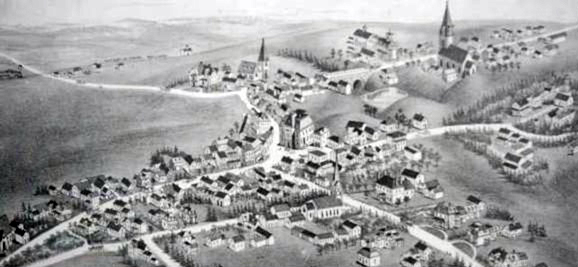
During its heyday in the 19th century, Dorchester was a busy and exciting place. The rich soils of the Memramcook marsh produced an abundance of agricultural goods for export to the growing urban markets of Saint John and Halifax. Safe anchorages on both sides of Dorchester Island and luxuriant stands of spruce, pine and hackmatack in the surrounding forests encouraged the early development of shipbuilding and lumbering industries. During their peak years ca. 1850-ca. 1880, Dorchester’s leading shipbuilders, the Palmers, Chapmans and Hickmans, built, owned (together with mainly local investors like E.B. Chandler, Albert J. Smith and Thomas Keillor) and operated wooden sailing vessels that carried trade goods around the world. Together with their counterparts in Sackville and Moncton, they made Westmorland County’s shipbuilding industry the third largest in the province after Saint John and the Miramichi.
The rebuilding of the Westmorland County courthouse, jail and public record office in Dorchester after its predecessor at Mount Whatley burned in 1800 had a major impact on the village’s socioeconomic life and political culture. Conveniently located near the ‘highway’ on land donated by John Keillor, and invitingly equipped with a commodious tavern, it soon attracted lawyers, litigants and others on judicial or administrative business. Some of them settled in the new shiretown and made their name in the history of the county, the province and the country. Among them was Edward Barron Chandler, a brilliant Amherst-born lawyer who entered politics and went on to become a Father of Confederation, a Lieutenant Governor of New Brunswick and one of the most important men behind the development of the province’s railways. His very successful law practice attracted other brilliant young minds to apprentice with him, making Dorchester the regional centre for legal training. One of his protégés was Shediac-born Albert J. Smith, who also served in government and is best known today for his opposition to Confederation. When it came anyway, he accepted it and was later knighted for his outstanding service as federal Minister of Marine and Fisheries. Other Dorchester lawyers who played significant public roles include Acalus Palmer, a Member of Parliament and a judge on the Supreme Court of New Brunswick, Daniel Hanington, a premier of the province, Henry Robert Emmerson, a Minister of Marine and Fisheries as well as premier, and Sir Pierre-Amand Landry, a Member of Parliament, a Judge and later the Chief Justice of the New Brunswick Supreme Court as well as a key figure in the Acadian Renaissance.
As the shiretown, Dorchester was a major overnight stop on the stagecoach lines, which, together with activities associated with the courthouse, shipyards and docks, made for a lively social scene at the hotels, taverns and the village square. On a higher plane, congregations of Anglicans, Methodists, Baptists, Presbyterians and Roman Catholics worshiped in a spirit of tolerance and ecumenical harmony and sponsored events and activities that enriched the cultural and social life of the community.
When the age of wooden ships ended, Dorchester entered its long period of economic decline, but its rich cultural and social life endured for many decades in a setting of handsome homes and architecturally interesting public buildings, and left a legacy that still sustains the community.
If you are a history buff, we invite you to learn more about the heritage of Dorchester and the area:
The Stagecoach Era in Dorchester
by W. Eugene Goodrich
Domestic Textile Production in Early New Brunswick
by W. Eugene Goodrich
A Tale of Two Churches by Eldon Hay, Professor Emeritus of Religious Studies, Mount Allison University, about the Presbyterians of Dorchester and Rockland.
